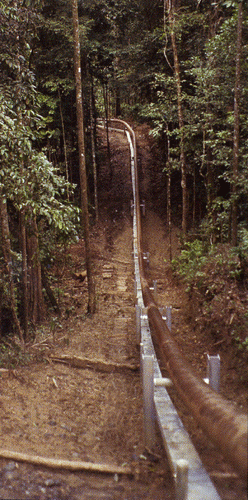|
|
|
Brazil begins building natural gas pipeline in the Amazon rainforest
FEATURE-Amazon gas heralds changes in Brazil rain forest
20 Dec 2004 13:00:13 GMT
Source: Reuters
By Andrew Hay

|
|
Pipeline in neigboring rainforest of Ecuador
|
URUCU, Brazil, Dec 20 (Reuters) - A tower of orange flame rises above the Amazon jungle, firing the energy goals of the Brazilian government.
It also gives environmentalists nightmares and heralds a dose of culture shock for the people of the rain forest.
The flare stack at state-run oil firm Petrobras' Urucu processing plant burns natural gas that Brazil plans to pipe to Amazon cities as part of plans to make Latin America's largest country self-sufficient in energy.
After years of opposition from environmentalists and Indian tribes, Petrobras on Jan. 2 will begin laying a 240-mile (383 km) pipeline from the town of Coari to Manaus, Amazonas state's capital of nearly 2 million people.
"If people want development that preserves the environment, we have to have energy," President Luiz Inacio Lula de Silva said when he laid the pipeline's first stone in April.
"It's no good people saying the Amazon has to be the sanctuary of humanity and forget there are 20 million people living here."
Beneath Urucu lies Brazil's largest onshore reserve of natural gas. Petrobras plans to ship the gas to energy-hungry cities, where it will be used to generate electricity at thermoelectric plants and replace costly, polluting oil-fired generators.
Brazil still imports oil and gas but hopes to be self sufficient by the time the Manaus pipeline goes on line in December 2006.
The government plans to meet future energy needs by expanding use of natural gas from the Amazon and a vast offshore reserve discovered last year.
"This gas pipeline is a mandatory project to guarantee energy supply," Sven Wolf, head of Petrobras' oil and gas production in the Urucu region, said.
PROGRESS AND PROBLEMS
Pipeline work begins as burning of the Amazon rain forest has made Brazil one of the world's top 10 polluters. Lula faces pressure to slow destruction of a jungle that is home to 30 percent of the world's plant and animal species.
Environmental groups fear future construction of a 320-mile (520 km) pipeline from Urucu to Porto Velho in Rondonia state will lead to deforestation of the Amazon's most isolated area.
That pipeline, set to begin construction in 2007, would pass through lands of isolated Indian tribes.
"There would be a huge influx from Rondonia, which is the single largest area of illegal logging and colonization on the Amazon frontier" said Roberto Roberto Smeraldi, environmental director of Friends of the Earth in Brazil.
"The pipeline route would be like an access road."
With oil revenues the biggest source of tax income in Amazonas state, and the federal government giving its blessing to Petrobras projects, critics like Smeraldi expect environmental authorities to turn a blind eye once pipelines are built.
Petrobras is Brazil's record holder for environmental fines and has a had a string of disasters in the past several years.
The town of Coari, already linked to Urucu by a pipeline, has seen its population more than triple to around 70,000 since 1990 as villagers were lured by oil and gas money. Today it is surrounded by slums and known as the prostitution center of the Solimoes region.
Communities the pipeline will pass by are set to get natural gas and receive $15 million in compensation funds to fight illiteracy and diseases like malaria.
The six towns have no running water, electricity or sanitation but will get broadband Internet connections via fiber-optic lines monitoring flow inside the pipelines.
Locals fear mayors will pocket gas money in a region of 180,000 where most people live off fishing or hunt game.
"They (Petrobras) bring development, but when money is siphoned off they bring problems," said Pedro Ribeiro da Silva, a surveyor's assistant at the Urucu plant, who like many of the more than 1,200 workers, comes from nearby Carauari.
Oversight of the project by 50 organizations is meant to limit corruption, Amazon State Environmental Secretary Virgilio Viana said.
The body is made up mostly of state, federal and municipal government agencies and includes some groups representing indigenous groups and farmers. But there are no well-known national or international non-profit groups or any critics of the project such as Greenpeace or Friends of Earth.
"It's all a process of negotiation," Viana said.
Source: REUTERS NEWS SERVICE
CONTENT COPYRIGHT REUTERS NEWS SERVICE. THIS CONTENT IS INTENDED SOLELY FOR EDUCATIONAL PURPOSES.
mongabay.com users agree to the following as a condition for use of this material:
This site contains copyrighted material the use of which has not always been authorized by the copyright owner. Such material is made available in an effort to advance understanding of environmental issues. This constitutes 'fair use' of any such copyrighted material as provided for in section 107 of the US Copyright Law. In accordance with Title 17 U.S.C. Section 107, the material on this site is distributed without profit. If you wish to use copyrighted material from this site for purposes of your own that go beyond 'fair use', you must obtain permission from the copyright owner.
If you are the copyright owner and would like this content removed from mongabay.com, please contact me.
|